New Math Department Chair Faces Challenges: Fostering Community, Math Pipeline Retention, and Making Space

Mathematics Department Chair, Jeremy Tyson, in front of the mathematics building.
October 10, 2018
In his 17th year at Illinois, first as a Professor, then as Interim Chair, and now the new Chair of Illinois’ Mathematics Department since August of 2018, Jeremy Tyson is pretty familiar with both his department’s achievements as well as the challenges it faces.
As with most newly installed chairs, he's made some plans for down the road. But before addressing areas that could use improvement, he first takes stock of the department’s strengths. For instance, he’s proud of the faculty’s work to date, and lauds their instructional expertise.
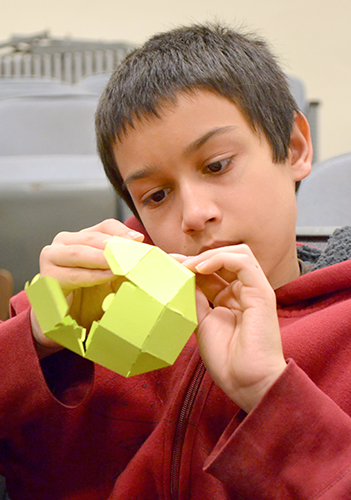
A participant in one of Math's Gathering for Gardner days folds an Archimedean solid. (Photograph courtesy of Christy Glaze.)
“I am really impressed with all of my colleagues and the efforts that they put into their teaching and into their mentoring of students,” he shares. “There's a lot of good things going on in this department already.”
Such as their work with undergraduate students. But while he’s proud of their programs to date, he also thinks there are things Math can do to make the situation better for undergrads. “Certainly there are a lot of issues related to undergraduate education that I am pretty passionate about,” Tyson says, adding that, “There certainly are things that can be changed and improved.”
For instance, one challenge he’s addressing is the significant growth in their undergraduate math major population—which he finds both rewarding and at the same time challenging.
“It's a good thing,” he acknowledges. “We're very pleased that there is so much interest in mathematics and mathematical sciences as a profession,” then cites the one big drawback: logistics. “It does make things challenging to have so many students,” he admits. Up about 50% in the last decade, the department currently has 1,200+ math majors, with about 300 freshmen joining the department every year. Given the classroom size restrictions of Altgeld (the castle-esque structure on the corner of Green and Wright that provides a picturesque backdrop for Alma Mater and houses the department), they have a hard time finding large enough rooms to teach in, so math classes are taught all over the place. For example, most intro courses, usually taught in large sections, can't really fit in Altgeld.
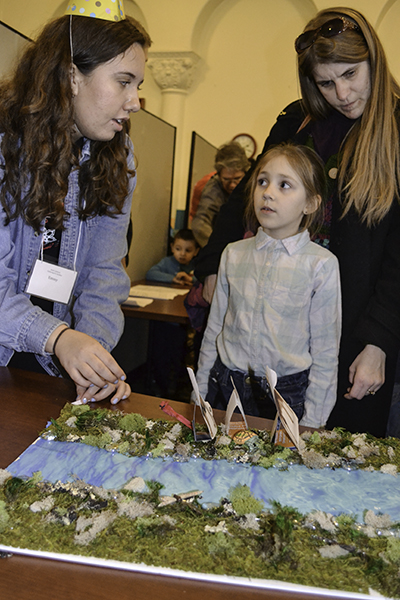
Illinois sophomore Emily Alameda does the Crossing the River acitvity with a local youngster at the Riddle Mania station during the Math Carnival: Gathering for Gardner.
Another challenge Tyson faces is coming up with ways to make the experience more personalized for students in their program. He wants to give them “a better sense of a cohort, so that math majors coming into the program feel like they are part of a community and part of a group from the beginning.”
This can be especially challenging when they’re in a class of 300, where only a small percentage of students in those classes are actually math majors, but are physics, engineering, or science majors. In fact, his students may not meet fellow math majors in their classes until they’ve been here for some time, maybe their junior year. So he’s been devising ways to provide social, professional, and/or academic experiences for students early in the program to “help them to see that there is a community of math majors.”
For instance, one academic strategy he’s been implementing is a 100-level math course, MATH 199, Intro to Undergraduate Mathematics, which he taught in Spring 2018 semester and will offer again in Spring 2019. He had developed the course before becoming interim chair and decided he wasn't going to give it up even though he’s now the chair.
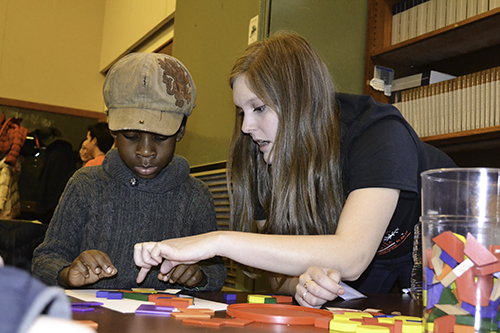
An Illinois math student (right) works on a tile puzzle with a local youngster at the Math Carnival's Tile Emporium station.
About 35 students participated in the pilot course, which met once a week for an hour and a half. Around 10 different faculty members gave 40-minute lectures on interesting mathematics topics appropriate for high school seniors or first year undergrads but not necessarily related to calculus, which they're getting already. “I want them to see that mathematics is much, much more than calculus,” he explains. During the second half of the class period, a 40-minute active learning collaboration, different grad students visit every week to talk about various opportunities for undergrad math majors at Illinois: study-abroad programs, summer internships, summer research experiences, etc.
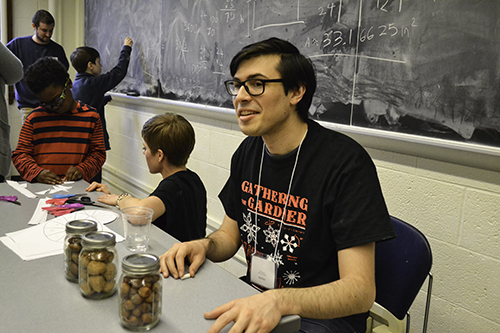
Second year math grad student Hadrian Quan gives a visitor to the Estimation Station at the Math Carnival pointers on how to estimate the number of nuts in the three jars.
While Tyson hopes to eventually increase the number of students in the course, he says one challenge related to this is to still maintain the close focus and level of involvement. Regarding possible changes in the Spring 2019 edition, he didn’t target specific areas professors should address during the pilot, but gave them free reign. However, next time, he may try to have a common theme around issues of computational mathematics, quantitative methods, or possibly statistics. “We're still thinking about what the focus might be,” he explains.
In regard to using social events to foster community, several of Math’s student groups are interested in promoting social interaction between undergraduates and graduate students in order to help provide cohesiveness within this large math major population.
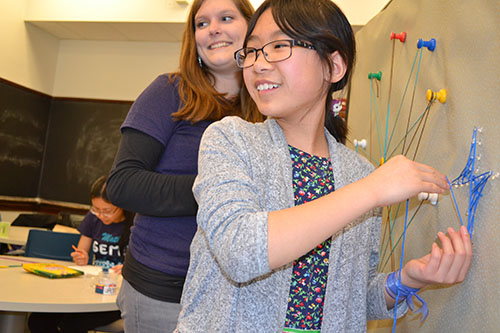
Emily Heath (left), AWM’s Outreach Chair, working with a participant during the string art workshop at GEMS 2018.
Another challenge Tyson and company face has to do with ensuring the flow of students along the math pipeline so they end up choosing math careers down the road. The pipeline is comprised of getting young children interested in math, keeping their interest piqued through the middle school and high school years, recruiting students into math (hopefully at Illinois), then fostering the retention of undergraduate math students once they’re here to ensure that they stay in math.
Tyson says improving retention—plugging the leaks in the pipeline as students move through the program—is one issue the department is addressing that is probably common in many institutions. “The percentages when the students enter, I'm sure, are not the same when we get to graduation,” he admits. “Students drop out along the way.”

A participant in Sonia Math Day 2017 plays one of the math games related to a torus.
Tyson believes attrition may affect certain populations more than others, especially underrepresented populations, due to several reasons: lack of support, lack of mentoring, and a lack of camaraderie and sense of cohesion among peers in students’ interest areas so that they lack cohorts to rely on for study aides.
In terms of retention of women in math, Tyson says around 35-40% of the grad students are women, which he calls “pretty high up there nationwide.” However, the percentage of undergrads is a bit lower; around 33% of those are women. In fact, the percentage has remained in the mid 30% range for a number of years.
“Increasing the numbers of women and underrepresented minority students within our major population, and retaining these students in the major throughout their time at Illinois, are priorities for me.” For Tyson, this issue motivates several of the ongoing initiatives the Math Department has instituted.
One of those is Mathways, which is designed to give underrepresented undergraduate students research experiences early on. Often done in small teams, these experiences build cohesion within a group, allowing students work on interesting, engaging problems and see mathematics in a very different way.

Some of the numerous geometric shapes IGL students use during outreach activities.
Mathways partners two successful groups within the department: the longstanding Merit program, which provides support for underrepresented populations, including minority students, women, and first-generation college students, in their early years in math, and the Illinois Geometry Lab (IGL), Math’s primary undergraduate community for research. Merit program courses run up through Calc 3, the minimum requirement to participate in IGL’s undergraduate research.
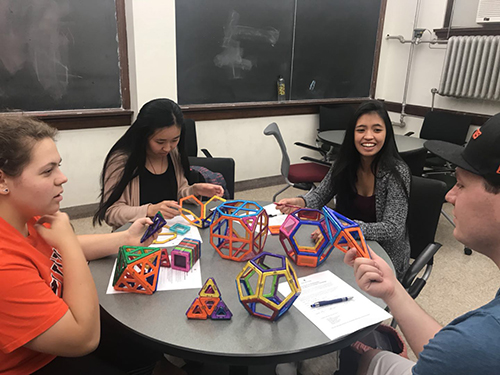
A recent IGL training session in October, 2018. (Photo courtesy of the IGL website.)
According to Tyson, Merit serves to “get students ready, and encourage them, and incentivize them to get into research...We have seen an increase in the number of Merit students that have applied to the IGL to participate in IGL projects,” Tyson says. “We have concrete evidence of students very much succeeding. They give talks, they give posters and presentations at undergraduate research conferences here on this campus and elsewhere. We've seen a lot of engagement with that program.”
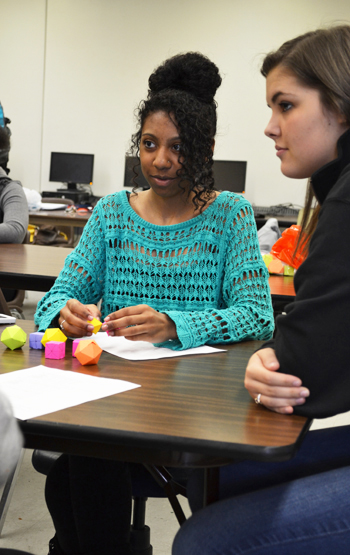
A high school student uses geometric shapes to conceptualize a math principle during the Tap-In after-school program hosted by Illinois Geometry Lab.
Of course, enticing young people into the STEM pipeline (which includes math), should begin quite early. As such, the IGL is designed to act as a sort of Pied Piper, using brightly colored geometric shapes and fun and engaging hands-on activities to pique youngsters’ interest in math. So in addition to their research, undergrads who are a part of IGL participate in outreach activities, hoping to spark young people’s interest in math via various educational activities in local schools as well as the community.
In addition to IGL, the graduate AWM (Association for Women in Math) chapter has done a number of outreach events, including Saturday workshops, such as Sonia Math Day and Girls Engaged in Math and Science (GEMS), as well as their summer camp: Summer Illinois Math (SIM) Camp. Plus, the department has opened its doors to the public, encouraging elementary school class field trips, as well as large-scale, community open houses, such as the Gathering for Gardner event in recent years.
In terms of recruiting high schoolers to math at Illinois, the department’s undergraduate office works closely with the University’s admissions office to partner on various admitted students days and orange and blue days, when students and their families visit campus, giving students who are interested in math the chance to come here, tour the building, and talk to advisors and current students.
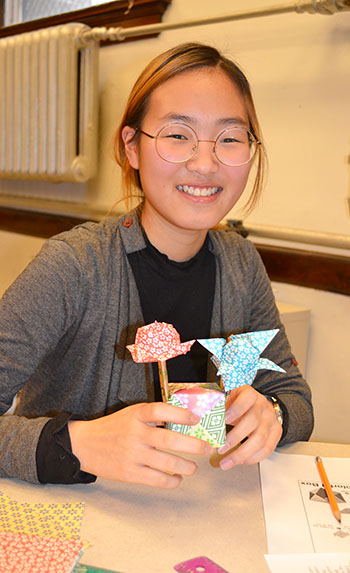
A 2018 GEMS participant shows off her origami creations.
Tyson shares another upcoming challenge/opportunity that he believes has the potential to really transform education in his department—the potential renovation of Altgeld. He believes the significant renovations that are in the works could have a tremendous impact on the student experience. For instance, he envisions big, new interactive rooms which will allow students to work in different configurations, not just desks and a blackboard but more interactive, collaborative spaces for students to gather and work in different contexts. “So I think there's huge potential for really transforming the way students interact with the department and the new facilities,” he shares.
Tyson’s philosophy or goal for math department is simple: to “make sure that we as a department are highly visible—both on campus and within the community—where people can see the breadth of what we do here and the real interest in applicability of mathematics. What we work on in this department really is applications across the sciences, across society in many different ways.” He explains that some of the IGL’s research projects have looked at the mathematics of social science, of human systems and human interactions, and of the internet, so he’d like to provide opportunities for people to see the different kinds of things that go on in the department. “The IGL is an organization in the department that's really charged with being a public face and being the face of the outreach and engagement of the department, so that's certainly something I want to continue,” he adds.
Story by Betsy Innes, Communications Specialist, I-STEM Education Initiative. Photos by Betsy Innes unless otherwise noted.
More: Faculty Feature, Illinois Geometry Lab, Mathmatics, 2018
 AWM members Hadrian Quan and Claire Merriman watch as a particpant creates tesselations with colorful tiles.
AWM members Hadrian Quan and Claire Merriman watch as a particpant creates tesselations with colorful tiles.













.jpg)
















